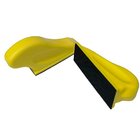View attachment 49295For 2” discs I made a rack out of PVC sections cut open on the front and screwed to a board. For 3” sections I’ve got verticals slots. Each rack has a cover with a plexiglas front that I remove when I’m sanding. The plexiglass is overkill, but I happened to have some left over from another project.
What do you use the golf clubs for, Lou?
Is that for when you get frustrated and just want to throw something? Ha,ha! 🙂
(I gave away my golf clubs many years ago.....so these days, I just grab any ol' thing that's handy! Ha,ha,ha!)
-----odie-----










